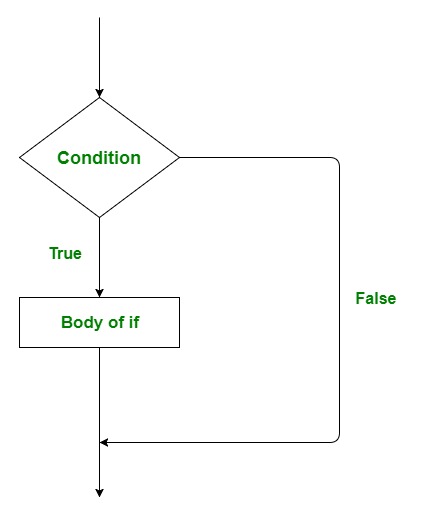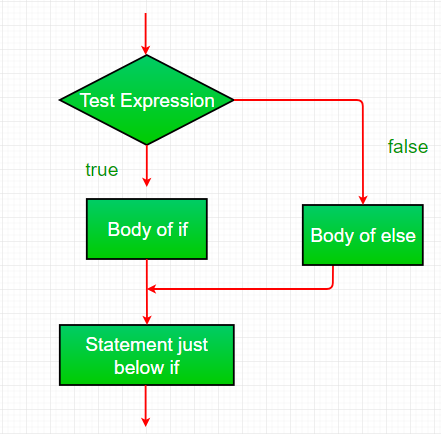R If Else Conditions
Last Updated :
19 Dec, 2023
The if-statement in Programming Language alone tells us that if a condition is true it will execute a block of statements and if the condition is false it won’t. But what if we want to do something else if the condition is false? Here comes the R Programming Language else statement. We can use the else statement with the if statement to execute a block of code when the condition is false.
Syntax of if-else statement in R Language
if (condition) {
# code to be executed if condition is TRUE
} else {
# code to be executed if condition is FALSE
}

if-else statement in R
Working of if-else statements in R Programming
- Control falls into the if block.
- The flow jumps to Condition.
- Condition is tested.
- If the Condition yields true, goto Step 4.
- If the Condition yields false, goto Step 5.
- The if-block or the body inside the if is executed.
- The else block or the body inside the else is executed.
- Flow exits the if-else block.
Flowchart if-else statement in R

R – if-else statement
Conditions and If Statements
Here we will show the use of logical conditions in if statements. Adjust the values and conditions as needed for our specific requirements.
| Equal |
== |
x == y |
| Not equal |
!= |
x != y |
| Greater than |
> |
a > b |
| Less than |
< |
x < y |
| Greater than or equal to |
>= |
x >= y |
| Less than or equal to |
<= |
x <= y |
Ifelse Function in R Programming
R
x <- 5
if(x > 10)
{
print(paste(x, "is greater than 10"))
} else
{
print(paste(x, "is less than 10"))
}
|
Output
[1] "5 is less than 10"
Here in the above code, Firstly, x is initialized to 5, then the if-condition is checked(x > 10), and it yields false. Flow enters the else block and prints the statement “5 is less than 10”.
Ifelse Function in R Programming
R
x <- 5
if(x == 10)
{
print(paste(x, "is equal to 10"))
} else
{
print(paste(x, "is not equal to 10"))
}
|
Output
[1] "5 is not equal to 10"
Nested if-else statement in R
The if-else statements in R can be nested together to form a group of statements and evaluate expressions based on the conditions one by one, beginning from the outer condition to the inner one by one respectively. An if-else statement within another if-else statement in R better justifies the definition.
Syntax
if(condition1){
# execute only if condition 1 satisfies
if(condition 2){
# execute if both condition 1 and 2 satisfy
}
}else{
}
Ifelse Function in R Programming
R
x <- 15
if (x < 10) {
print("x is less than 10")
} else {
if (x < 20) {
print("x is between 10 and 20")
} else {
print("x is greater than or equal to 20")
}
}
|
Output
[1] "x is between 10 and 20"
- In this example, we first define a variable x with the value of 15.
- Then we use a nested if-else statement to check the value of x.
- The outer if-else statement checks if x is less than 10. If it is, we print the message “x is less than 10”. If x is not less than 10, we move on to the nested if-else statement inside the else block.
- This nested if-else statement checks if x is less than 20. If it is, we print the message “x is between 10 and 20”. If x is not less than 20, we print the message “x is greater than or equal to 20”. Since x is 15, the code will print “x is between 10 and 20”.
Ifelse Function in R Programming
R
grades <- 85
income <- 25000
if (grades >= 80) {
if (income <= 30000) {
print("Congratulations, you are eligible for a scholarship!")
} else {
print("Sorry, your income is too high to qualify for a scholarship.")
}
} else {
print("Sorry, your grades are too low to qualify for a scholarship.")
}
|
Output
[1] "Congratulations, you are eligible for a scholarship!"
- In this example, we first define two variables, grades and income, to represent a student’s grades and income, respectively.
- Then we use a nested if-else statement to check if the student is eligible for a scholarship.
- The outer if-else statement checks if the student’s grades are 80 or above. If they are, we move on to the nested if-else statement inside the if block. This nested if-else statement checks if the student’s income is 30,000 or less.
- If it is, we print the message “Congratulations, you are eligible for a scholarship!” If the student’s income is more than 30,000, we print the message “Sorry, your income is too high to qualify for a scholarship.” If the student’s grades are below 80, we print the message “Sorry, your grades are too low to qualify for a scholarship.”
- This nested if-else statement can be expanded upon to include additional conditions, such as residency or enrollment status, to determine scholarship eligibility.
Share your thoughts in the comments
Please Login to comment...